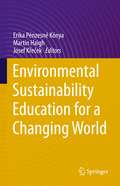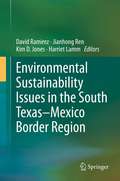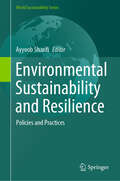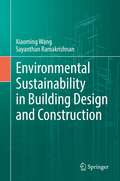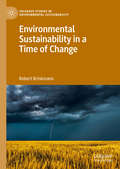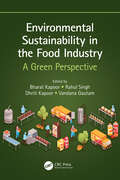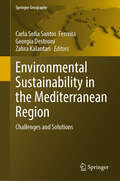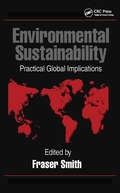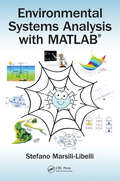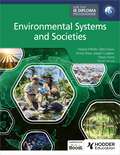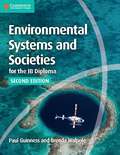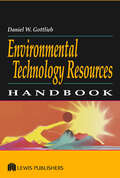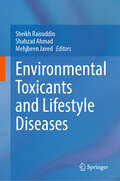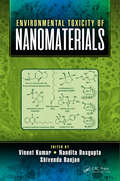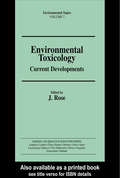- Table View
- List View
Environmental Studies: Looking Around class 4 - NCERT - 23
by National Council of Educational Research and TrainingThe NCERT textbook "Environmental Studies - Looking Around" for Class IV provides a comprehensive introduction to environmental awareness for young learners. The book aims to instill a sense of responsibility and appreciation for the natural world among students. Through engaging narratives, colorful illustrations, and interactive activities, it covers diverse topics such as the importance of water, air, and soil, biodiversity, and the significance of conservation. The content is presented in a child-friendly manner, encouraging students to observe and understand their surroundings. The textbook not only imparts knowledge about the environment but also encourages students to develop a sustainable and eco-friendly mindset. With a focus on fostering curiosity and a sense of wonder, "Environmental Studies - Looking Around" serves as a valuable resource for nurturing environmentally conscious citizens from an early age.
Environmental Success Stories: Solving Major Ecological Problems and Confronting Climate Change
by Frank DunnivantUnlike many titles on environmental issues that portend a dark future, Environmental Success Stories delves into the most daunting ecological and environmental challenges humankind has faced and shows how scientists, citizens, and a responsive public sector have dealt with them successfully.In addition to presenting the basic chemical and environmental science underlying problems like providing clean drinking water, removing DDT and lead from agriculture and our homes, and curtailing industrial pollution, this book also discusses the political actors, agency regulators, and community leaders who have collaborated to enact effective legislation. Sharing the stories of the people, organizations, and governments who have addressed these problems successfully, Frank M. Dunnivant explains how we might confront the world's largest and most complex environmental crisis: climate change. Now is the time for rededicated scientific exploration and enlightened citizen action to save our environment, and Dunnivant's book offers a stirring call to action.
Environmental Sustainability Education for a Changing World
by Josef Křeček Martin Haigh Erika Pénzesné KónyaGlobally, there is a need to promote and empower practical action towards better environmental conservation and greater sustainability; education aspires to achieve and motivate this – one mind at a time. This book advances a future-oriented vision of the development of environmental sustainability education in settings outside the high-school. It provides practical guidance for teacher practitioners and policy makers in community-oriented environmental sustainability education. It promotes a modern holistic approach to sustainability learning in and by the community through participative engagement with sustainability issues. Its special foci include working with volunteers and citizen scientists, through museums or through re-purposing Higher Education. Its approach emphasises the implementation of the United Nation’s Sustainable Development Goals and cooperation with environmental management professionals. This book’s cosponsors include the International Association for Headwater Control and FAO – European Forestry Commission’s Working Party on the Management of Mountain Watersheds, as well as the International Environmental Education Conferences, Eger, Hungary and the Hungarian Academy of Science’s Subcommittee on Future Studies. Community education has long been a goal for environmental management, whose practitioners realise that interventions, such as biodiversity conservation, are only truly sustainable when supported by the local land-user and stakeholder communities; this depends upon these stakeholders’ understanding why intervention is necessary.
Environmental Sustainability Issues in the South Texas–Mexico Border Region
by Harriet Lamm Jianhong Ren David Ramirez Kim D. JonesEnvironmental sustainability issues in a fragile, semi-arid region and its coastal area, which experience climate changes from extreme drought conditions to the effects of hurricanes over a period of weeks to years, provide specific challenges for the ecosystems and the populations existing within the region. The research presented focuses on the problems and some solutions specific to the South Texas-Mexico border region, on both sides of the Rio Grande, focusing on water and air pollution.
Environmental Sustainability and Biotechnology: Opportunities and Challenges (Microorganisms for Sustainability #46)
by Naveen Kumar Arora Piyush Pandey Jitendra MishraThis book assembles a global perspective on the challenges and opportunities to achieve environmental sustainability through biotechnology. The book highlights agenda for utilizing scientific knowledge including the use of beneficial microbes, and biotechnological approaches for combating key global issues related to environmental sustainability. Additionally, to evolve adaptive processes and mitigation approaches, certain novel insights on resilience mechanisms, sustainability principles, and bio-inputs are discussed. The book also showcases advanced technologies in the area of biotechnology, including use of microbes in biodegradation, bioremediation, sustainable agriculture and food security. This book is valuable for environmentalists, ecologists, policy makers and industrial entrepreneurs. The book is also a reference source for researchers, undergraduate and graduate students of the environment science and biotechnology fields.
Environmental Sustainability and Development in Organizations: Challenges and New Strategies
by Clara Inés Pardo MartínezThis book aims to analyze contexts and perspectives in the relationships between environmental sustainability, human development and organizations. The book combines different scientific approaches for enhancing our understanding of environmental sustainability, development economics and evaluate what the actual conditions in emerging economies are and how developing new process could improve the well-being of developing countries. Employing a collaborative and interdisciplinary approach, the authors work to determine the main related factors and outcomes of the relationship between challenges and new strategies in the environmental sustainability, ultimately seeking to guide public policies to enhance the welfare of the population of an emerging economy.
Environmental Sustainability and Education for Waste Management: Implications for Policy and Practice (Education for Sustainability)
by Cheuk Fai Chow Winnie Wing Mui So John Chi Kin LeeThis book focuses on education for environmental sustainability, in particular the area of solid waste management. Presenting the latest studies from different countries, industries and education sectors on the approaches and innovative ideas to educate future citizens regarding sustainable development of our planet, it is of interest to educators, academics, tertiary students, policy-makers, environmental scientists, social scientists and practitioners who have been involved in education, policy, science, and technological innovation for solid waste management.
Environmental Sustainability and Resilience: Policies and Practices (World Sustainability Series)
by Ayyoob SharifiThis volume offers a comprehensive exploration of the environmental challenges and innovations shaping our world. It represents a collective effort to understand and address the pressing issues that define our era, from climate change to resource management. Through a series of expert contributions, it examines the intricate relationship between human activity and the environment, seeking pathways to a more sustainable and just future. The insights presented are crucial for anyone looking to contribute to the global pursuit of Sustainable Development Goals. This volume is an invaluable resource for policymakers, researchers, educators, students, and activists alike; offering a well-rounded perspective on the multifaceted aspects of environmental sustainability - it's both a call to collective action as well as reminder urging us all—to rethink our strategies collaboratively towards achieving healthier world and more resilient planet.
Environmental Sustainability for Engineers and Applied Scientists
by Magdalena Svanström Greg PetersThis textbook presents key theoretical approaches to understanding issues of sustainability and environmental management, perfectly bridging the gap between engineering and environmental science. It begins with the fundamentals of environmental modelling and toxicology, which are then used to discuss qualitative and quantitative risk assessment methods, and environmental assessments of product design. It discusses how business and government can work towards sustainability, focusing on managerial and legal tools, before considering ethics and how decisions on environmental management can be made. Students will learn quantitative methods while also gaining an understanding of qualitative, legal, and ethical aspects of sustainability. Practical applications are included throughout, and there are study questions at the end of each chapter. PowerPoint slides and jpegs of all the figures in the book are provided online. This is the perfect textbook on environmental studies for engineering and applied science students.
Environmental Sustainability in Building Design and Construction
by Xiaoming Wang Sayanthan RamakrishnanThis monograph offers analyses of construction activities using various key concepts and assessments of sustainable development, and provides students and researchers with methodologies and design aspects for the sustainable development of the built environment. Additionally, the book demonstrates various national and international policies for assisting architects, engineers and policy makers in understanding the relevant decision-making approaches to sustainable development in construction. The book begins by reviewing the background of sustainability and sustainable development. The focus then turns to the effects of climate change on the built environment, including impacts of energy and carbon emissions, as well as constraints on water and waste management. The remaining chapters discuss the necessary approaches to achieve sustainable waste management, energy efficient building design, and resilience and adaptation in the built environment In eight chapters, the book encourages readers to think independently, logically and objectively about the complex issues presented by the applications of sustainable development in construction, including resource efficiency, environmental impacts, human health, building economics and social development.
Environmental Sustainability in a Time of Change (Palgrave Studies in Environmental Sustainability)
by Robert BrinkmannEnvironmental Sustainability in a Time of Change is the first book in a new Palgrave series on Environmental Sustainability. It takes a fresh look at the dynamic field of environmental sustainability by exploring the interconnections between climate change, water, energy, waste, land use, ecosystems, food, and transportation. It also provides an extensive summary on sustainability management, data analysis, mapping, and data sources. Brinkmann highlights how environmental sustainability challenges are distinctly different in the developed world, where sustainability is largely a choice, versus the developing world, where many struggle with basic existence due to war, migration, and water or food scarcity. He takes a broad systems and historic approach to contextualize environmental sustainability prior to the 1987 Brundtland Report and utilizes many contemporary examples throughout the text, analyzing numerous case studies from many areas of the world including China, Yemen, Malaysia, Egypt, and Florida. This book questions traditional approaches to sustainability that highlight the need for an equal balance of economic development, environmental protection, and social equality to achieve sustainability. This book focuses on a new line of thinking that places environmental sustainability as the key foundation in how to manage sustainability in a time of change. Our planet is quickly becoming environmentally unsustainable due to global consumption and unsustainable economic development and it is high time for a fresh approach. This book will be of great value to academics, practitioners, and students interested in environmental sustainability from a myriad of fields including geology, geography, biology, ecology, economics, business, sociology, anthropology, and other areas that intersect the interdisciplinary field of sustainability.
Environmental Sustainability in the Food Industry: A Green Perspective
by Rahul Singh Bharat Kapoor Dhriti KapoorCriticisms facing the food processing industry include adverse ecological impacts like decline in biodiversity, environmental degradation, water pollution, eutrophication, greenhouse gas emissions, and the loss of agricultural land. Environmental Sustainability in the Food Industry: A Green Perspective delves into the effect of food processing on the environment, human health, nutrition, energy efficiency, nanotechnology in food industry, and the maintenance of ecological sustainability. The book presents eco-friendly approaches to reducing the impacts of food processing on the environment and to promoting sustainable development. The focus of this text is how to implement green practices in the food industry to reduce the negative impacts of food processing on the ecosystem, as well as to improve food quality for better human health and nutrition. The text also explains the food industry’s focus on sustainable aspects in resource conservation and reduction of energy consumption. Key Features: Describes the contribution of the food industry sector on human health and nutrition Covers eco-friendly approaches to reducing negative impacts of food processing on the environment Discusses the uses of advanced techniques such as nanotechnology, non-thermal techniques, and more to improve food processing The book highlights details related to the food industry and environmental issues. It is a great resource for students, researchers, and professionals alike, as well as anyone with an interest in green paths to food quality and nutrition.
Environmental Sustainability in the Mediterranean Region: Challenges and Solutions (Springer Geography)
by Zahra Kalantari Carla Sofia Santos Ferreira Georgia DestouniThe book provides a cross sectoral assessment of the most relevant environmental challenges in the Mediterranean region, including land and water degradation, water and food security, and solution opportunities for these. It also discusses main change drivers, such as changes in climate, land use, population, demographics and technology. Additionally, the book explores improved management, participatory planning, and nature-based strategies and measures for meeting the key environmental challenges, e.g. restoring degraded areas and improving land management in different land uses (e.g. forest, coastal and urban areas). Finally, the book addresses needs and opportunities to improve governance and partnerships for assuring sustainable development in the Mediterranean region.
Environmental Sustainability: Practical Global Applications
by Fraser SmithIn 1994, representatives from all over the world met in Costa Rica to discuss the impact of ecological economics on developing countries. That groundbreaking conference laid the foundation for this new collection of research on environmental sustainability. While most discussions on sustainable development focus on the industrialized nations, Environmental Sustainability: Practical Global Applications takes a different angle: it presents the views of the developing countries themselves on issues such as wildlife resources in Nambia, timber production in Costa Rica, property rights and land reform in South Africa, and other steps being taken to implement environmentally sustainable economies around the world.This is an ideal text for students of natural and social sciences, development professionals and entrepreneurs seeking opportunities for ecologically sustainable businesses. Academics will find it useful as a source of current research and for making new contacts in the field. For anyone interested in exploring the link between man and his environment-specifically, the relationship between economics and ecology- Environmental Sustainability, is a must.
Environmental Systems Analysis with MATLAB®
by Stefano Marsili-LibelliExplore the inner workings of environmental processes using a mathematical approach. Environmental Systems Analysis with MATLAB® combines environmental science concepts and system theory with numerical techniques to provide a better understanding of how our environment works. The book focuses on building mathematical models of environmental systems, and using these models to analyze their behaviors. Designed with the environmental professional in mind, it offers a practical introduction to developing the skills required for managing environmental modeling and data handling. The book follows a logical sequence from the basic steps of model building and data analysis to implementing these concepts into working computer codes, and then on to assessing their results. It describes data processing (rarely considered in environmental analysis); outlines the tools needed to successfully analyze data and develop models, and moves on to real-world problems. The author illustrates in the first four chapters the methodological aspects of environmental systems analysis, and in subsequent chapters applies them to specific environmental concerns. The accompanying software bundle is freely downloadable from the book web site. It follows the chapters sequence and provides a hands-on experience, allowing the reader to reproduce the figures in the text and experiment by varying the problem setting. A basic MATLAB literacy is required to get the most out of the software. Ideal for coursework and self-study, this offering: Deals with the basic concepts of environmental modeling and identification, both from the mechanistic and the data-driven viewpoint Provides a unifying methodological approach to deal with specific aspects of environmental modeling: population dynamics, flow systems, and environmental microbiology Assesses the similarities and the differences of microbial processes in natural and man-made environments Analyzes several aquatic ecosystems’ case studies Presents an application of an extended Streeter & Phelps (S&P) model Describes an ecological method to estimate the bioavailable nutrients in natural waters Considers a lagoon ecosystem from several viewpoints, including modeling and management, and more
Environmental Systems and Societies for the IB Diploma (For the IB Diploma)
by Virginia D'Britto Öykü Dulun Emma Shaw Joseph CazabonDeveloped in cooperation with the International Baccalaureate® Ensure full coverage of the updated syllabus with a coursebook that implements inquiry-based and conceptually-focused teaching and learning, written by highly experienced global authors. - Explore the three key concepts in the new course: perspectives, systems and sustainability which allow students to deepen their understanding and make interdisciplinary connections throughout, with HL content clearly signposted. - Prepare students for assessment with a range of options: exam-style questions, top tip boxes and hints to help avoid common mistakes. - Integrate TOK into lessons and create opportunities for cross-curriculum study with case studies, real world examples and up-to-date data. - Provide plenty of practise with activities, review questions and chapter summaries allowing students to recap themes and test knowledge. - Enable students to feel confident in course terminology with ESL support, definitions, key terms and a glossary.
Environmental Systems and Societies for the IB Diploma (For the IB Diploma)
by Virginia D'Britto Öykü Dulun Emma Shaw Joseph CazabonDeveloped in cooperation with the International Baccalaureate® Ensure full coverage of the updated syllabus with a coursebook that implements inquiry-based and conceptually-focused teaching and learning, written by highly experienced global authors. - Explore the three key concepts in the new course: perspectives, systems and sustainability which allow students to deepen their understanding and make interdisciplinary connections throughout, with HL content clearly signposted. - Prepare students for assessment with a range of options: exam-style questions, top tip boxes and hints to help avoid common mistakes. - Integrate TOK into lessons and create opportunities for cross-curriculum study with case studies, real world examples and up-to-date data. - Provide plenty of practise with activities, review questions and chapter summaries allowing students to recap themes and test knowledge. - Enable students to feel confident in course terminology with ESL support, definitions, key terms and a glossary.
Environmental Systems and Societies for the IB Diploma (IB Diploma Series)
by Brenda Walpole Paul GuinnessThis book covers the syllabus for the IB Diploma Programme Environmental Systems and Societies, which is offered at Standard Level only. Our understanding of the environment and its importance to our lives has grown rapidly over recent decades and the Environmental Systems and Societies course
Environmental Technology Handbook: 2nd Edition (Applied Energy Technology Ser.)
by James G SpeightHistorically, the development of civilization has upset much of the earth’s ecosystem leading to air, land, and water pollution. The author defines pollution as the introduction of a foreign substance into an ecosystem via air, land or water. This book delves into issues that effect the everyday lives of people who come in contact with these hazards. By examining these issues, this body of work aims to stimulate debate and offer solutions to the ever-growing threat to the environment and humanity. Includes problems with each chapter, Explores issues such as control of gaseous emissions, waste recycling and waste disposal, Explains physical and thermal methods of waste management, Provides definitions and resources for future reference, Discusses the history of environmental technology.
Environmental Technology Resources Handbook
by Daniel W. GottliebThis handbook guides the user to hundreds of technologies, practices, partnership opportunities, and funding resources. Presented in non-technical language, it covers hundreds of publicly available resources for pollution prevention, control, remediation, and assessment. Environmental Technology Resources Handbook will help you:
Environmental Technology and Innovations: Proceedings of the 1st International Conference on Environmental Technology and Innovations (Ho Chi Minh City, Vietnam, 23-25 November 2016)
by Vladimír Kočí, Tomáš Ruml, Phan Dao & Pham Anh DucThis book covers a wide range of topics within enviromental engineering and technologies including: • General environmental engineering• Clean energy and sustainability• Water and wastewater management• Public health and environment. The application areas range from emerging pollutants of air, soil and water environment, remediation technologies, clean energy and sustainability of biofuels, waste to energy, water and wastewater management, public health and the environment, quality and safety of food production to environmental planning and management and policies for cities and regions. The papers cover both theory and applications, and are focused on a wide range of sectors and problem areas. Integral demonstrations of the use of reliability and environmental engineering are provided in many practical applications concerning major technological approaches. Environmental Technology and Innovations will be of interest to academics and professionals working in a wide range of industrial, governmental and academic sectors, including water and waste management, energy generation, fuel production and use, protection of natural heritage, industrial ecology, man health protection and policy making.
Environmental Toxicants and Lifestyle Diseases
by Mehjbeen Javed Sheikh Raisuddin Shahzad AhmadThis book discusses the relationship between environmental toxicants and lifestyle diseases and explores how pollutants impact human health. With contributions from leading experts, this volume delves into the latest research and evidence-based approaches to understanding and managing these critical health issues. The chapters cover a wide array of topics, including emerging contaminants like endocrine disruptors and microplastics. The book also covers the link between environmental toxicants and diseases such as obesity, diabetes, cardiovascular conditions, cancer, infertility, chronic lung diseases, and stress. Additionally, it explores innovative management strategies for these lifestyle diseases through nanotechnological applications, natural products, and dietary interventions. Researchers in toxicology, biochemistry, environmental science, clinical research, and related fields will find this book invaluable. It provides critical insights for regulatory agencies, policymakers, health professionals, and students at all levels.
Environmental Toxicity of Nanomaterials
by Vineet Kumar Shivendu Ranjan Nandita DasguptaEnvironmental Toxicity of Nanomaterials focuses on causes and prevention of environmental toxicity induced by various nanomaterials. In sixteen chapters it describes the basic principles, trends, challenges, and future directions of nanoecotoxicity. The future acceptance of nanomaterials in various industries depends on the impacts of nanomaterials on the environment and ecosystem. This book analyzes the safe utilization of nanotechnology so the tremendous prospect of nanotechnology can be achieved without harming either living beings or the environment. Environmental Toxicity of Nanomaterials introduces nanoecotoxicity, describes various factors affecting the toxicity of nanomaterials, discusses various factors that can impart nanoecotoxicity, reviews various studies in the area of nanoecotoxicity evaluation, and describes the safety and risk assessment of nanomaterials. In addition, the book discusses strategies for mitigating nanoecotoxicity. Lastly, the authors provide guidelines and protocols for nanotoxicity evaluation and discuss regulations for safety assessment of nanomaterials. In addition to environmental toxicologists, this book is aimed at policy makers, industry personnel, and doctoral and postdoctoral scholars.
Environmental Toxicology
by Edward A. LawsEnvironmental Toxicology provides a detailed, comprehensive introduction to this key area of sustainability and public health research. The broad coverage includes sections on ecological risk assessment, monitoring, mechanisms, fate and transport, prevention, and correctives, as well as treatment of the health effects of solar radiation and toxicology in the ocean. The 23 state-of-the-art chapters provide a multi-disciplinary perspective on this vital area, which encompasses environmental science, biology, chemistry, and public health.
Environmental Toxicology
by J. RoseBecause our chemical environment affects our physical and mental well-being, it is a matter of increasing concern and is therefore attracting much research effort. This timely collection of essays highlights current developments in the field of environmental toxicology. Chapters analyze the carcinogenic, mutagenic, genotoxic, and neurotoxic effects


